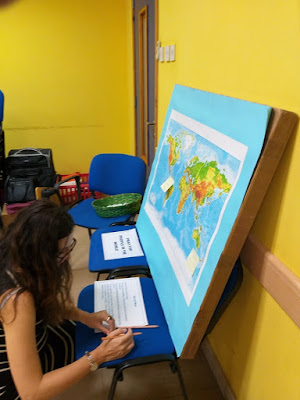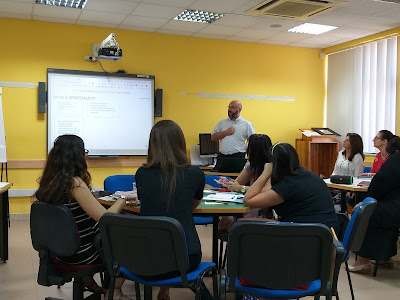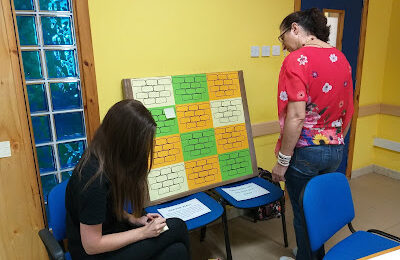On Wednesday, 18th September 2019, the Spiritual Development in Schools unit delivered a training session at NCC Hamrun, about Prayer Spaces and how they help children and young people to express themselves in writing.
A group of educators who were participating in the course ‘Award in Teaching Writing Skills’, organised by the National Literacy Agency, attended this session as part of their final workshop which focused on how to use creative writing strategies with learners of different abilities in a balanced literacy approach classroom.
The session commenced with everyone introducing him/herself. Participants were then invited to get up and roam around the room for about twenty minutes to explore Prayer Spaces. They could do the activities in any order and either with one another or alone.
 |
| Pipe Cleaner People |
 |
| Sorry whiteboards |
 |
| Pray for the World |
 |
| Peace Garden |
The feedback from participants after they experienced prayer spaces was very encouraging. They shared about their favourite prayer space and why; whether any of the stations were challenging and why; and asked any other questions relevant to this activity.
What participants said:
· It never occurred to me that I could use objects and everyday things to reflect and pray.
· At first I was talking and moving around the place with my colleagues, then as I listened to the background music, I calmed down and moved on every prayer space on my own slowly and peacefully.
· Prayer Spaces gave me the chance to reflect and pray on various aspects of my life.
· If we had more time I would have loved to stay longer.
· It gave me space to calm down and think about life issues and situations.
· I can see that prayer spaces will definitely help children in my class as the activities are very creative and simple and children love to write, draw or do something else which is creative.
· Since it is experiential, it is more effective than most of the talking I do in class.
· I got very emotional throughout this experience.
· I loved the background music and how you set them up.
· I think this helps children deal with their emotions too.
· Some of the activities were light and enjoyable, some others were challenging and profound.
By using online editor, Fr Reuben presented a couple of questions about prayer and spirituality. Participants used their smartphones to connect to the presentation where they could answer the questions and visualize their responses in real-time.
 |
| What is Prayer? What is Spirituality? |
Fr Reuben proceeded with ‘The Theory of Prayer Spaces,’ how they’ve started in schools, how they are set up in different settings and how they contribute to the spiritual development of children and young people. He showed examples of how the activities help them relate to the Self, Other People, The World and God.
He spoke about the values of prayer spaces that they are spiritual, reflective, inclusive and professional. Participants had time to discuss, share their views and ask questions about prayer spaces, how to access resources and how to plan and set them up in their particular school.
 |
| Theory of Prayer Spaces |
Silvana showed how the prayer space experience gives the opportunity for children to develop skills in writing, reading, listening and speaking in a safe environment.
Writings reflect what the person is going through in his/her interiority; that is, what is going on in one’s minds, thoughts and feelings. Prayer activities related to forgiveness, gratitude, self-identity, worries and fears, hopes and dreams, sorrows, mistakes and life’s big questions are a few examples of what children and young people write about. They also write about what is external, what is happening around them and in the world, when they hear the news, about war, the refugee crisis, natural disasters, climate change and so on.
Participants could see examples of written prayers on sticky notes, whiteboards, paper templates and pieces of cardboard paper. They were made aware of how one could use things and objects to pray with and that are easily found at school, at home or outside like for example stones, plasticine, pipe cleaners, maps, plasma balls, sand and mirrors.
Different ways of how children engage on prayer spaces were discussed and participants could see how children can engage in prayer activities on their own, either in pairs or in a small group in various places and settings both indoors and outdoors.
Some examples of this included instances when prayer spaces were set up in collaboration with the National Literacy Agency mainly during an Intergenerational Writing Club and various Family Writing Activities in Malta and Gozo.
 |
| Sharing of good practice |
The Spiritual Development in Schools Unit would like to thank the National Literacy Agency for this collaboration and all participants for their input throughout the session.
Thanks be to God.
Photos taken from https://www.facebook.com/MaltaWritingProgramme/




